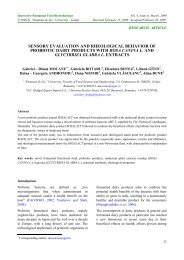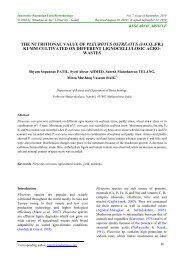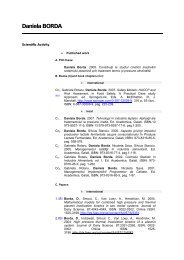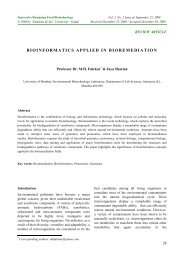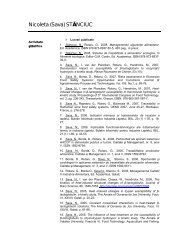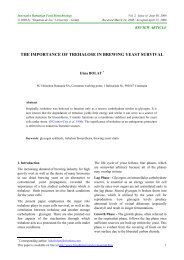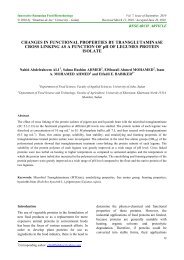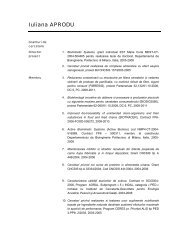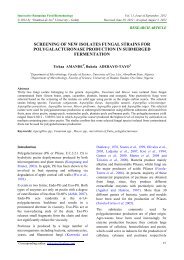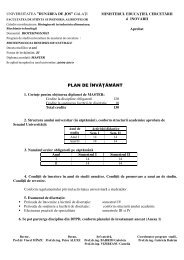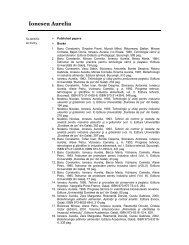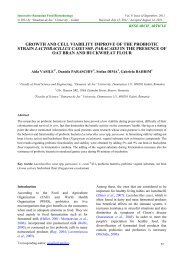probiotic properties of lactobacilli strains isolated from ... - Bioaliment
probiotic properties of lactobacilli strains isolated from ... - Bioaliment
probiotic properties of lactobacilli strains isolated from ... - Bioaliment
You also want an ePaper? Increase the reach of your titles
YUMPU automatically turns print PDFs into web optimized ePapers that Google loves.
Sieladie, Zambou, Kaktcham, Cresci, Fonteh: Probiotic Innovative Romanian Food Biotechnology (2011) 9, 12-28<br />
<strong>properties</strong> <strong>of</strong> <strong>lactobacilli</strong> <strong>strains</strong> <strong>isolated</strong> <strong>from</strong> raw<br />
cow milk in the western highlands <strong>of</strong> Cameroon<br />
Genotypic identification<br />
RAPD-PCR method was used to estimate the<br />
diversity between three potential <strong>probiotic</strong> <strong>strains</strong><br />
<strong>of</strong> L. plantarum including 1RM, 11RM and 29V<br />
(Figure 1). L. plantarum 1RM and 11RM were<br />
selected for their high acidotolerance. Selection <strong>of</strong><br />
L. plantarum 29V was based to its high<br />
acidotolerance and strong antimicrobial activity.<br />
Among the three primer used (M13, RP and R5),<br />
primer M13 was retained for its reproductivity.<br />
The pr<strong>of</strong>iles <strong>of</strong> RAPD-PCR products for primer<br />
M13 obtained <strong>from</strong> L. plantarum 1RM, 11RM and<br />
29V differed <strong>from</strong> each other and <strong>from</strong> those <strong>of</strong><br />
patented <strong>strains</strong> <strong>from</strong> Camerino University ( L.<br />
plantarum N° 319, L. rhamnosus L.RHM501 and<br />
L. paracasei L.PRC502). These pr<strong>of</strong>iles are little<br />
similar to the one <strong>of</strong> L. plantarum N° 319.<br />
Therefore, <strong>strains</strong> <strong>of</strong> L. plantarum 1RM, 11RM<br />
and 29V constitute different new potentially<br />
<strong>probiotic</strong> <strong>lactobacilli</strong>.<br />
Lactic acid bacteria have been consistently<br />
demonstrated to be responsible for the spontaneous<br />
lactic acid fermentation <strong>of</strong> homemade dairy<br />
products in Cameroon, where three genera have<br />
previously been identified: Lactobacillus,<br />
Enterococcus and Lactococcus (Zambou et al.,<br />
2004). Zambou et al. (2008) demonstrated that<br />
<strong>strains</strong> <strong>of</strong> Lactobacillus plantarum constituted the<br />
dominant species <strong>of</strong> <strong>lactobacilli</strong> present in dairy<br />
products <strong>from</strong> western highland region <strong>of</strong><br />
Cameroon. In our study, all the 107 isolates<br />
belonged to facultative hetero-fermentative group.<br />
Lactobacilli have the most claims to be selected<br />
among potential <strong>probiotic</strong>s (FAO/WHO, 2002).<br />
Probiotics are health-promoting microorganisms.<br />
The criteria used to select potential <strong>probiotic</strong>s are<br />
related to acid and bile tolerance, production <strong>of</strong><br />
antimicrobial substances, cholesterol metabolism,<br />
production <strong>of</strong> useful enzymes and safety for food<br />
and clinical use (Ouwehand et al., 1999).<br />
This paper is available on line at http://www.bioaliment.ugal.ro/ejournal.htm<br />
21



